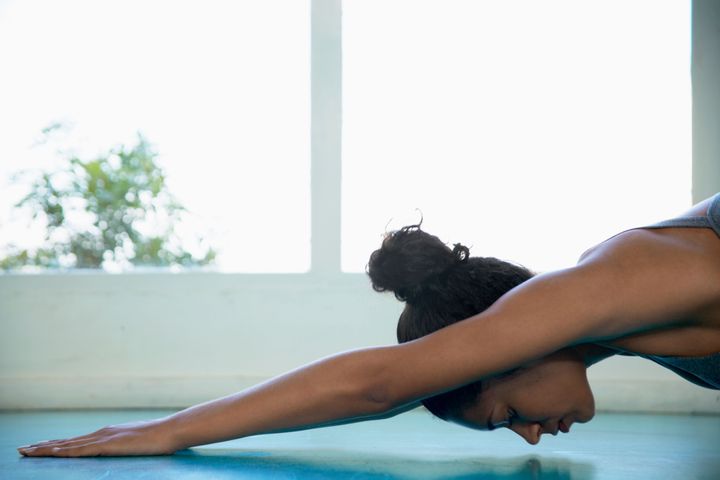
When I began teaching yoga in 2004, what interested me most was music; more specifically, how music and postures played along together. Introduced to yoga through a dance class, music had become a necessary component for movement. While I learned to appreciate silence studying under some teachers, that path didn't interest me when transitioning to teacher. For eight years I have spent as much time producing playlists -- and producing music for yoga playlists -- as I have on sequencing asanas.
With a background in international music journalism, I predominantly turned to global artists to find the right tone and tempo. A longtime lover of the classical Indian music traditions, that sound never provided the right temperament for what I was trying to accomplish. New York City streets gave birth to the head-nodding, fist-shaking beats of hip-hop, and I certainly wasn't going to rely on 13-beat cycles from an ancient culture when my students intrinsically understood the four-four punchiness of sharp rim shots and demanding bass lines. I sourced modern sounds from Africa, Jamaica, the Middle East and the Balkans, occasionally finding solace in the familiar and comforting welcomeness of a Ben Harper or Jeff Buckley ballad, seemingly tailor-made for the quietude of Savasana.
This constant quest of exposing Americans to more international music (and by default, culture) hasn't shifted since moving to Santa Monica, though I am happy that a number of West Coasters have stepped up to borrow from these same passions to engineer throbbing low-ends laced with atmospheric melodies. One of the most proficient beatmakers is fellow Los Angelean DJ Drez, whose latest chapter in his Jahta Beat series, The Lotus Memoirs (Black Swan), is a brilliant exploration of the possibilities of marrying bhajans with bass. That particular instrument pounded from my car the moment 'Ganesh's Theme' hit the speakers, the sonic assault lasting for 78 foot-stomping minutes.
Drez is a yoga studio mainstay. With thick, winding dreadlocks like Shiva's jatawi, he creates beats much harder than his gentle demeanor would have you guess. Two features jumped out immediately: the exceptional guitar contributions, especially the Eastern modes on "Guru Mantra," which leads to the second, Marti Nikko. Parvati to Drez's yogic lore, her voice blends the hard edge of gritty bhajans and mantras with delicate beauty. She's bouncy on "Guru Mantra" but simply deadly on my favorite track, "Krishna's Dub." It's a deep song by a deep producer, one who tackles a cover of a '60s era protest classic ("For What It's Worth") and his longtime love of dub in the vain of, say, Augustus Pablo ("Dragon Mudra"). Expect this to be heard in studios worldwide.
Talk about yoga mainstays: The triple billing of Rara Avis, Amani Friend and Treavor Moontribe has been the behind behind many DVD and soundtracking classics. After a trilogy of recent releases, the trio known as Desert Dwellers commissioned reliable remixers and returned with Downtemple Dub: Remixed (Black Swan), a twelve-track outing of a number of their percussion-heavy, dub-laden tracks. While many remix comps are choppy, this one is highly listenable from take-off to touchdown. For classes, I'm inclined towards a chugging rendition of "Point of Awakening" by Androcell, rocket fuel by Duke Mushroom on the danceable "Crossing Beyond" (he really does), two contributions by another sturdy percussionist, the Bay Area's Drumspyder, with my inclination leaning towards the ambient "Bodhi Mandala," and a throbbing assault by Canadian producer Eccodek on "Pranafestation." The closing mixes by Eastern Sun and Aes Dana are the perfect segue from Flow to Restore to Relax; sequenced like a Vinyasa class, these guys had everything in mind, and fortunately so did the producers behind their delicious remixes.
Traveling west from the West Coast, we end up in Japan where a producer by the name of Gio Makyo has been unintentionally creating some of the best yoga music on the planet. Unintentional, that is, as he's not a 'yoga' producer, but his predominantly downtempo, spacious vibe has long been included in my playlists. So I knew when he reached out and specifically mentioned yoga, I had to listen. He was not lying.
Purnima (Dakini) marks his first live band recording, even though the DJ has assembled and performed with musicians in the past. Adding in adept players on the santoor (Jimi Miyashita), percussion (darbuka, tabla, daf; Junzo Tateiwa) and strings (saz, rubab, oud; Madoka Sakuma), as well as a mainstay in his show, bellydancing (Hayati), the five tracks on this lush and luscious recording are hypnotic masterpieces. Allowing each song the space of 10+ minutes, the musicians have plenty of time to meander without ever disappointing. Trance music originally intended to draw the listener in and subdue their brain waves -- 14 minutes of the pulsing "Nebusoku" leaves you craving more.
Stretching without sounding repetitious is challenging, and yet acoustics meets physiology here, for what is yoga but devotedly returning to silence to create space? For many of us, a soundtrack is required. These three albums are permanent members of that club.